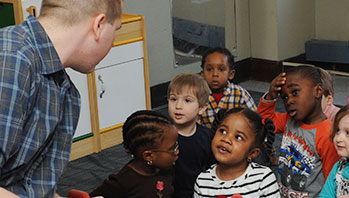- chart paper
- marker
- fruit samples (e.g., apple, peach, kiwi)
- vegetable samples (e.g., carrot (root), lettuce (leaf), asparagus (stem), broccoli (flower))
- fruit
- leaf
- root
- seed
- vegetable
MA Standards:
Speaking and Listening/SL.PK.MA.1: Participate in collaborative conversations with diverse partners during daily routines and play.
Language/L.PK.MA.6: Use words and phrases acquired through conversations, listening to books read aloud, activities, and play.
MA Draft STE Standards:
Life Sciences/From Molecules to Organisms: Inheritance and Variation of Traits/LS1/3.A: Describe/draw and compare the body parts of animals (including themselves) and plants they are investigating [System] and explain functions of some of the observable body parts. [Structure and Function]
Life Sciences/From Molecules to Organisms: Inheritance and Variation of Traits/LS1/3.C: Use their sense in their exploration and play to gather information. [Structure and Function]
Head Start Outcomes:
Language Development/Receptive Language: Attends to language during conversations, songs, stories, or other learning experiences.
Language Development/Expressive Language: Uses language to express ideas and needs.
Talk Together: Fruits, Vegetables, Seeds

© Commonwealth of Massachusetts, Department of Early Education and Care (Jennifer Waddell photographer). All rights reserved.
STEM Key Concepts: Many foods that animals, including humans, eat come from plants; We eat certain leaves, roots, fruits, and seeds; Fruits have seeds; Seeds hold what a plant needs to make more of itself
ELA Focus Skills: Follow Directions, Listening and Speaking, Predicting, Vocabulary
Educator Prep: Place the vegetables and fruit in a place that is easily accessible to children. Slice the fruit so children can explore the seeds inside
Safety Tips:
- Remind children to wash their hands before and after the activity.
- Take children’s dietary needs into account before introducing them to any food items.
Review with children the different parts of plants that animals eat. Record their responses on a chart titled “Fruits, Vegetables, Seeds.” Discuss with children the leaf and root vegetables they ate in the salad they made last week.
Then draw attention to the fruits and ask children what they see inside each fruit (seeds). Ask children, Why do you think the seed is inside the fruit? Elicit that the fruit protects the seed. Ask, Why do you think seeds need to be protected? Review that the seed is the part that makes another plant. Ask children to name a fruit they like to eat. Then ask, What other plants do you know that have seeds? (tomato, cucumber) Chart children’s responses.
Remind children to water their plants and to be sure the plants are in the sunlight.
Educator Tip: People generally call some foods vegetables though the foods are actually fruits, for example, tomatoes and cucumbers. You may choose to say that in science, fruits are the part of the plant that carries the seed, but people call some of these foods vegetables.
English Language Learners: Have children learn key vocabulary by identifying cognates in their native language. Use the key word in a sentence and have children repeat it in English and then in their own language.
